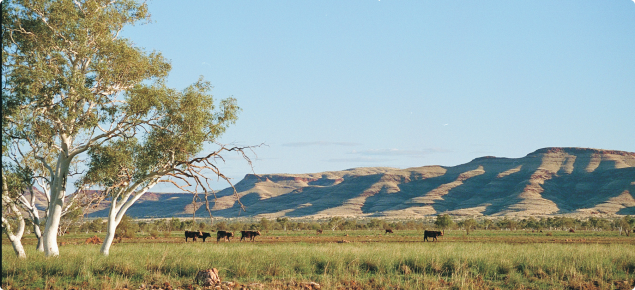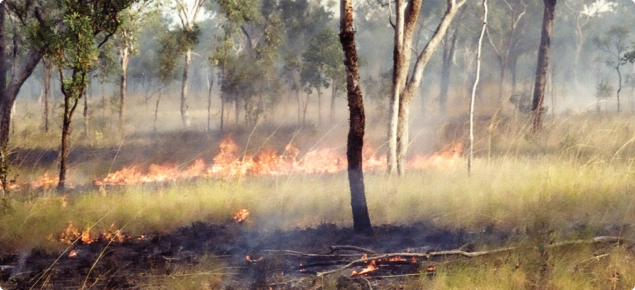How pastoral enterprises might be affected by climate change
There is considerable regional variation in climate projections for the extensive pastoral areas and we have provided information on climate change, its impacts and adaptations, by pastoral region.
This information is general in nature and will need detailed analysis before being used for any individual business.
- Kimberley and eastern Pilbara
- Western Pilbara, Murchison, Gascoyne and western Goldfields
- Eastern Goldfields and southern rangelands
Kimberley and eastern Pilbara
This region is projected to become hotter, with higher evaporation rates, have about the same annual rainfall, and experience more extremes of weather (droughts, intense rainfall). Managing for the longer term will be even more important for pastoralists in this changed climate.
Projected climate change
The projections for this region are (please note the levels of confidence in the projections):
- increased daily maximum, minimum and average temperatures (high confidence)
- increased potential evapotranspiration (high confidence)
- increased intensity of extreme rain events (high confidence)
- increased intensity of tropical cyclones (medium confidence)
- largely unchanged average annual rainfall (low confidence)
- increased inter-annual variability in rainfall
- increased time in drought (low confidence)
- increased frequency of severe drought (medium confidence).
Impacts of climate change
- The mix of forage species may change for several reasons:
- increased temperatures and carbon dioxide concentrations could reduce forage digestibility and protein content.
- more-intense rainfall events may increase deep recharge of the soil profile and enable woody plants to encroach into grasslands.
- Inter-annual variability in forage production is likely to increase.
- The likelihood and intensity of wildfire may increase.
- More-intense tropical cyclones may increase the risks of soil erosion and infrastructure damage.
- Increased temperatures will increase heat stress for livestock, which will:
- reduce livestock growth and reproductive success
- increase livestock water requirements, while also potentially reducing water quality
- increase livestock exposure and susceptibility to new parasites and disease.
Adapting to climate change
Livestock management
There are several ways to adapt livestock to warmer conditions:
- use within-breed selection for heat tolerance
- use heat-tolerant breeds, such as Brahman cattle and crosses
- select for disease and parasite tolerance
- modify timing of mating and weaning based on seasonal conditions.
Grazing and pasture management
Increase pastoral value by:
- increasing the number and distribution of watering points where this suits the landforms
- use 'self-herding' techniques to increase the grazing range
- decreasing paddock size to facilitate paddock recovery and forage use, based on suitable landforms.
Where fresh water resources exist:
- use irrigation to grow fodder
- finish cattle by lot feeding
- conserve fodder.
Regenerate degraded land that is potentially productive.
Use decision support tools
There are many apps, services and calculators to help improve management decisions:
- forage production models incorporating utilisation rates
- seasonal and long-range weather forecasts
- remotely sensed production data
- soil water calculators.
Livestock water
Water resources may be a limiting factor for livestock production. There are ways to increase available water:
- Design dams and catchments to cope with projected rainfall and evaporation rates.
- Treat roaded catchments with chemical sealants to reduce the amount of rainfall required before water runs off the catchment.
- Plan for increased investment in tanks and dam storage.
Business management
There are many ways to adapt business management to new climatic conditions:
- Consider systems facilitating trade cattle through alliances between pastoral and southern broadacre enterprises.
- Consider alternative on-lease activities, such as horticulture or tourism.
- Where water supplies are available, grow irrigated fodder and use:
- hay or silage
- stand and graze systems.
- Consider new income streams from carbon farming activities, such as modified savanna burning or herd management.
- Consider off-farm income.
- Undertake training in business management.
- Maintain information and innovation sharing networks and links.
Reduce soil erosion risk in a more-variable climate
Options are:
- match stocking rates to carrying capacity (season)
- reduce total grazing pressure to allow degraded areas to revegetate.
Western Pilbara, Murchison, Gascoyne and western Goldfields
This region is projected to become hotter, with higher evaporation rates, lower winter and spring rainfall, and greater variability in weather and climate (more-intense rainfalls and variation between years).
Projected climate change
The projections for this region are (please note the levels of confidence in the projections):
- increased daily maximum, minimum and average temperatures (high confidence)
- increased hot spells
- increased potential evapotranspiration (high confidence)
- increased intensity of extreme rain events (high confidence)
- reduced winter and spring rainfall, little change in summer rainfall (medium confidence)
- increased inter-annual variability in rainfall
- increased time in drought (medium confidence)
- increased frequency of severe drought (medium confidence).
Impacts of climate change
- Reduced rainfall and higher temperatures could reduce forage production by 10–20%.
- The mix of forage species may change for several reasons:
- Increased temperatures and carbon dioxide concentrations could reduce forage digestibility and protein content, particularly if tropical plant species (C4 plants) became more dominant.
- More-intense rainfall events may increase deep recharge of the soil profile and enable woody plants to encroach into grasslands.
- Inter-annual variability in forage production is likely to increase.
- The likelihood and intensity of wildfire may increase.
- More-intense rainfall events may increase the risks of soil erosion and infrastructure damage.
- Increased temperatures will increase heat stress for livestock which will:
- reduce livestock growth and reproductive success
- increase livestock water requirements, while also potentially reducing water quality
- increase livestock exposure and susceptibility to new parasites and disease.
- Declining rainfall and continued climate variability may increase stress on already degraded rangeland ecosystems.
Adapting to climate change
Livestock management
There are several ways to adapt livestock to warmer conditions:
- use within-breed selection for heat tolerance
- use heat-tolerant breeds, such as Brahman cattle and crosses
- select for disease and parasite tolerance
- modify timing of mating and weaning based on seasonal conditions.
Grazing and pasture management
Increase pastoral value by:
- increasing the number and distribution of watering points where this suits the pasture types
- use 'self-herding' techniques to increase the grazing range
- decreasing paddock size to facilitate paddock recovery and forage use, based on suitable landforms.
Where fresh water resources exist:
- use irrigation to grow fodder
- finish cattle by lot feeding
- conserve fodder.
Regenerate degraded land that is potentially productive.
Use decision support tools
There are many apps, services and calculators to help improve management decisions:
- forage production models incorporating use rates
- seasonal and long-range weather forecasts
- remotely sensed production data (see Pastoral remote sensing information for managers, Western Australia)
- soil water calculators.
Livestock water
Water resources may be a limiting factor for livestock production. There are ways to increase available water:
- Design dams and catchments to cope with current and projected rainfall and evaporation rates.
- Treat roaded catchments with chemical sealants to reduce the amount of rainfall required before water runs off the catchment.
- Plan for increased investment in tanks and dam storage.
Business management
There are many ways to adapt business management to new climatic conditions:
- Consider systems facilitating trade cattle through alliances between pastoral and southern broadacre enterprises.
- Consider alternative on-lease activities, such as sandalwood production or tourism.
- Where water supplies are available, grow irrigated fodder and use:
- hay or silage
- stand and graze systems.
- Consider new income streams from carbon farming activities, such as herd management.
- Consider off-farm income.
- Undertake training in business management.
- Maintain information and innovation sharing networks and links.
Reduce soil erosion risk in a more-variable climate
Options are:
- match stocking rates to carrying capacity (season)
- reduce total grazing pressure to allow degraded areas to revegetate.
Eastern Goldfields and southern rangelands
This region is projected to become hotter, with higher evaporation, about the same annual rainfall, and increased weather and climate variability.
Projected climate change
The projections for this region are (please note the levels of confidence in the projections):
- increased daily maximum, minimum and average temperatures (high confidence)
- a likely increase in heat extremes, such as hot spells
- increased potential evapotranspiration (high confidence)
- unchanged average annual rainfall (low confidence)
- increased intensity of extreme rain events (high confidence)
- increased inter-annual variability in rainfall
- increased time in drought (high confidence)
- increased frequency of severe drought (medium confidence).
Impacts of climate change
- The mix of forage species may change for several reasons:
- Increased temperatures and carbon dioxide concentrations could reduce forage digestibility and protein content, particularly if tropical plant species (C4 plants) became more dominant.
- Inter-annual variability in forage production is likely to increase because of increased drought frequency, intensity and duration.
- The likelihood and intensity of wildfire may increase.
- More-intense rainfall events may increase the risks of soil erosion and infrastructure damage.
- Increased temperatures will increase heat stress for livestock which will:
- reduce livestock growth and reproductive success
- increase livestock water requirements, while also potentially reducing water quality
- increase livestock exposure and susceptibility to new parasites and disease.
- Continued climate variability may increase stress on already degraded rangeland ecosystems.
Adapting to climate change
Livestock management
There are several ways to adapt livestock to warmer conditions:
- use within-breed selection for heat tolerance.
- use heat-tolerant breeds, such as Brahman cattle and crosses.
- select for disease and parasite tolerance.
- modify timing of mating and weaning based on seasonal conditions.
- change species, for example, sheep or goats instead of cattle.
Grazing and pasture management
Increase pastoral value by:
- increasing the number and distribution of watering points where this suits the landforms
- use 'self-herding' techniques to increase the grazing range
- decreasing paddock size to facilitate paddock recovery and forage use, based on suitable landforms.
Where fresh water resources exist:
- use irrigation to grow fodder
- finish cattle by lot feeding
- conserve fodder
Regenerate degraded land that is potentially productive.
Use decision support tools
There are many apps, services and calculators to help improve management decisions:
- forage production models incorporating use rates
- seasonal and long-range weather forecasts
- remotely sensed production data
- soil water calculators.
Livestock water
Water resources may be a limiting factor for livestock production. There are ways to increase available water:
- Develop and maintain efficient bores and reticulation systems
- Where suitable, build dams and catchments to cope with current and projected rainfall and evaporation rates.
- Treat roaded catchments with chemical sealants to reduce the amount of rainfall required before water runs off the catchment.
- Plan for increased investment in tanks and dam storage.
Business management
There are many ways to adapt business management to new climatic conditions:
- Develop trade cattle alliances between pastoral and southern broadacre enterprises.
- Adopt alternative on-lease activities, such as sandalwood production or tourism.
- Where water supplies are available, grow irrigated fodder and use:
- hay or silage
- stand and graze systems.
- Investigate new income streams from carbon farming activities, such as herd management.
- Build off-farm income.
- Learn more about business management.
- Build information and innovation sharing networks and links.
Reduce soil erosion risk in a more-variable climate
Options are:
- match stocking rates to carrying capacity (season)
- reduce total grazing pressure to allow degraded areas to revegetate.
For more informaton
Download the full bulletin:
Sudmeyer, R A, Edward, A, Fazakerley, V, Simpkin, L, and Foster, I (2016), Climate change: impacts and adaptation for agriculture in Western Australia, Department of Agriculture and Food, Western Australia, Perth, Bulletin 4870.
Contact Wayne Fletcher for pastoral management adaptations in the southern rangelands.
Contact Kath Ryan for pastoral management adaptations in the northern rangelands.



